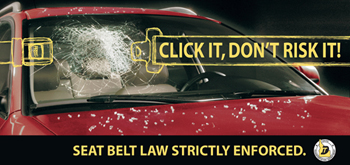
|
CONNECTIONS
|
IDAHO
ITD
HOME
IDAHO DMV
ITD NEWS
HIGHWAY
SAFETY
IDAHO STATE
POLICE
TRAVEL SERVICES
STATE OF IDAHO
NATIONAL
AASHTO
AAMVA
AAA of IDAHO
FEDERAL HIGHWAYS
FEDERAL AVIATION
IDAHO STATE POLICE
NHTSA
NTSB
TRB
U.S. DOT
Idaho
Transportation
Department
Public Affairs Office
P.O. Box 7129
Boise, ID 83707
208.334.8005
Fax: 208.334.8563
Email


Law enforcement to increase seat belt patrols
Law enforcement agencies throughout Idaho will conduct seat belt saturation patrols Feb. 7-19 to enforce Idaho’s seat belt law. The stepped-up enforcement coincides with National Child Passenger Safety Awareness Week and is part of the “Click It, Don’t Risk It!” campaign to increase seat belt use.
“Drivers need to take Idaho’s seat belt law seriously,” says Mary Hunter, ITD Office of Traffic and Highway Safety (OTHS). “It is the driver who is responsible for making sure all underage passengers are buckled up and that children are properly secured in a safety seat that’s right for their age and size.”
Idaho law requires all passengers to wear a seat belt. Adult drivers can be ticketed if passengers younger than 18 are not properly restrained. Court costs are added to the fine when the driver is younger than 18, and the driver or any occupant younger than 18 fails to wear a seat belt.
“Seat belts are your single best defense against injury or death in the event of a crash,” Hunter adds. “That alone is reason enough to buckle up, but it’s also the law.”
Seat belts prevent fatalities and serious injuries more than half of the time, according to the National Highway Traffic Safety Administration (NHTSA). In Idaho, 239 people were killed in crashes during 2003; 150 were not wearing seat belts.
Idahoans, not the individuals involved in those crashes, pay for 85 percent of all medical costs for crash victims, according to NHTSA. These costs are paid through insurance premiums, federal, state and local taxes, and increased charges for medical care. In Idaho, that amounts to $148 per person.
OTHS recommends booster seats for children age 4 to 8, unless they are at least 4 feet 9 inches tall. A booster seat elevates a child so a seat belt can fit correctly. Most seat belts are designed to protect an average–sized adult male. Young children using only seat belts are at risk of injuries to the abdomen and spine, and are four times more likely to suffer a serious head injury in a crash if they are not secured in a booster seat.
Between 2001 and 2003 in Idaho, nine children (ages 4-8) died and 73 were seriously injured in passenger vehicle crashes. Thirty-five of the injured children were unrestrained. During the same period, among children ages 9-14, 14 died and 134 were seriously injured. Fifty-seven percent of those children were not wearing seat belts.
 NHTSA
offers four simple ways to increase safety for children riding in motor
vehicles:
NHTSA
offers four simple ways to increase safety for children riding in motor
vehicles:
-
REAR-FACING INFANT SEATS in the back seat from birth to at least 1 year old and less than 20 pounds.
-
FORWARD-FACING TODDLER SEATS in the back seat from age 1 to about age 4, or 20 to 40 pounds.
-
BOOSTER SEATS in the back seat from about age 4 to at least age 8, or taller than 4 feet 9 inches.
-
SAFETY BELTS at age 8 or older, or taller than 4 feet 9 inches. All children 12 and younger, or less than 100 pounds, should ride in the back seat and never in front of an air bag.
During the “Click It, Don’t Risk It!” law enforcement mobilization and National Child Passenger Safety Awareness Week, OTHS will launch a media campaign to inform the public about the increased enforcement and the importance of proper safety restraint use for all passengers.
Messages will appear on television, radio and billboards around Idaho.
To receive educational materials or more information about seat belts or child passenger safety in Idaho, go to www.itd.idaho.gov/ohs/ or www.NHTSA.dot.gov .
Listen to the public service announcement.